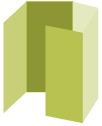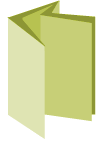Types of Folds
In general, there are only two basic types of folds: parallel and right-angle. Products containing parallel folds consist of folds that run parallel to each other. Right-angle folds are folds that run perpendicular to each of the preceding folds.
Common Parallel Folds
4-Page Standard / Single / Half
6-Page Standard / C-Fold / Business Letter
6-Page Standard / Gate
6-Page Accordion / Z-Fold
8-Page Parallel Map
8-Page Reverse Map
8-Page Parallel / Roll
8-Page Accordion
8-Page Double / Double Parallel
10-Page Accordion
16-Page Parallel Booklet
 |  |  |  |  |  |
 |  |  |  |  |
Common Right Angle Folds
8-Page Booklet with 2 Right Angle Folds (French Fold)
8-Page Right Angle - First Fold Short
12-Page Letter
12-Page Broadside - First Fold Short
16-Page Broadside
|
|
|
|
|
A variety of different folds are now being accomplished on many different shapes and sizes of printed materials. Paper and other substrate products can be folded either in-line during the production of the printed piece or off-line on folding machines ranging from free standing table-top folders to high speed production floor models.
In-line folding is generally best for large quantity products. Folding inline may result in lower press speeds, however the reduced speeds are accepted for the economies gained. It eliminates the additional cost of folding the product with an offline process. In-line folding is limited to only a few types of products and a few types of folds. Off-line folding or bindery folding provides the greatest number of different folds on high-speed machines referred to as knife folders, buckle folders or combination folders.
A knife folder is used primarily for booklet work due to the accuracy that can be achieved when producing right-angle folds, keeping the pages in close registration. A blunt steel blade pushes the internal part of the paper at the desired location between two rollers to create the fold in the material. The knife folder is a slower speed folder, but as stated, more precise on the folds.
A combination folder, as the name implies, provides both close registration and a higher speed for folding. The combination folder is used most often for large quantities and more complex folding jobs.
Paper Grain
The paper grain direction has much to do with the quality of the fold. Paper that is folded parallel with the grain of the paper will fold much more cleanly. A cleaner fold is produced because the paper fibers (grain) are running in the same basic direction as the fold. Only a few of the fibers provide any resistance to the folding action, which results in a high quality fold.
When a fold is applied perpendicular to the grain of the paper, the resulting fold may have a ragged appearance. A ragged fold is produced because all of the fibers are folded at one time creating resistance to the folding action. The ragged appearance of the fold is especially noticeable when folding heavy stocks.